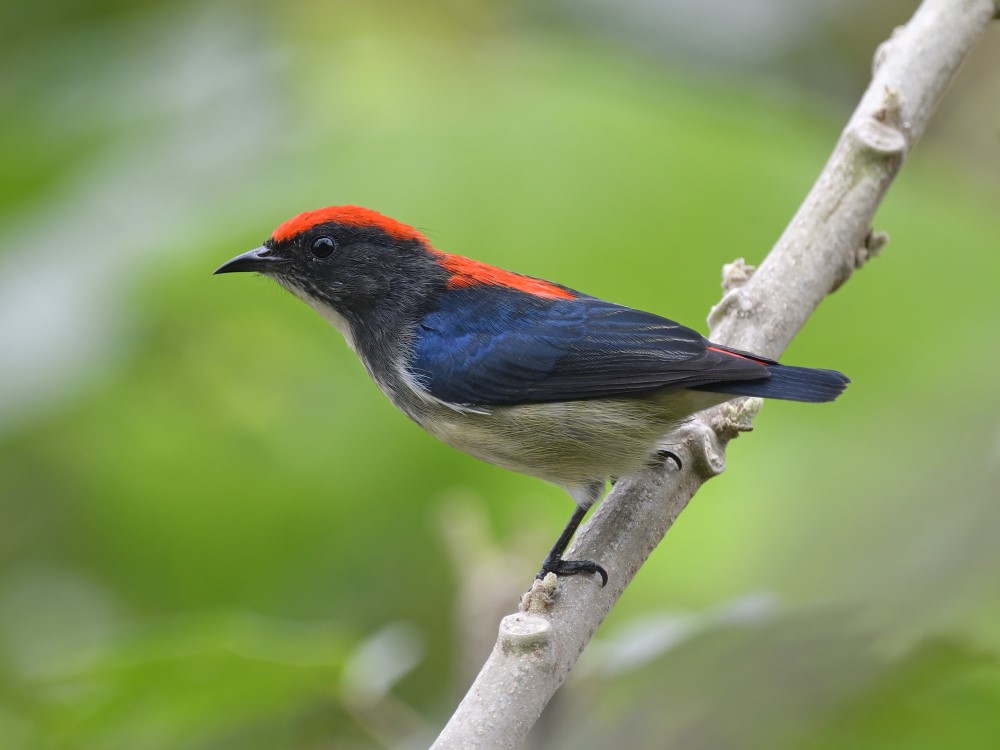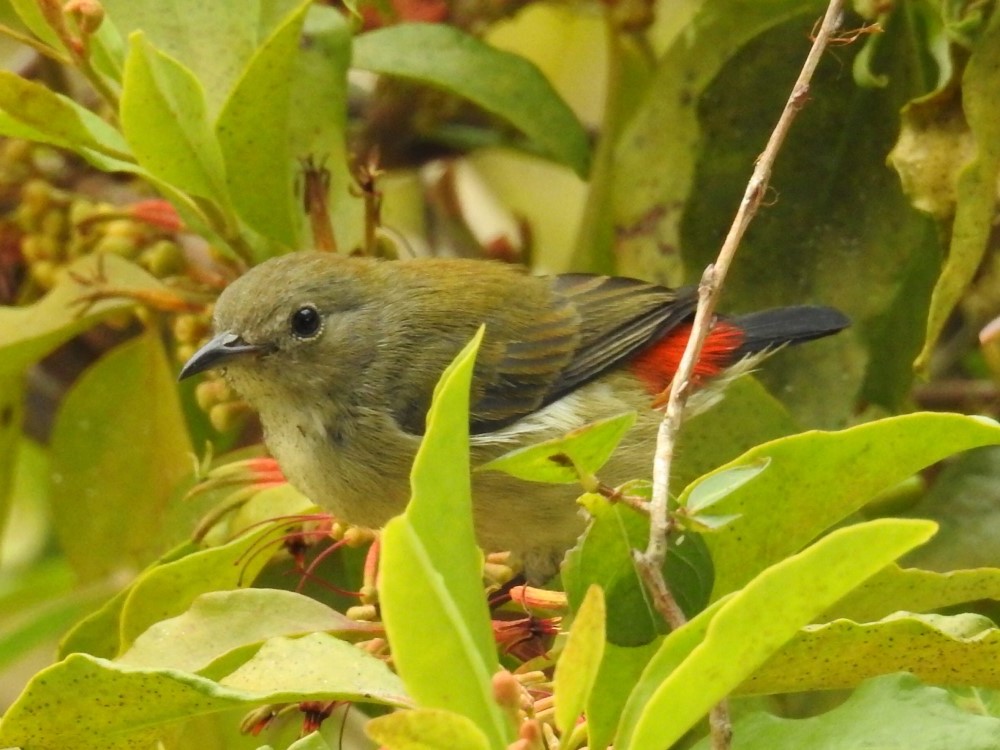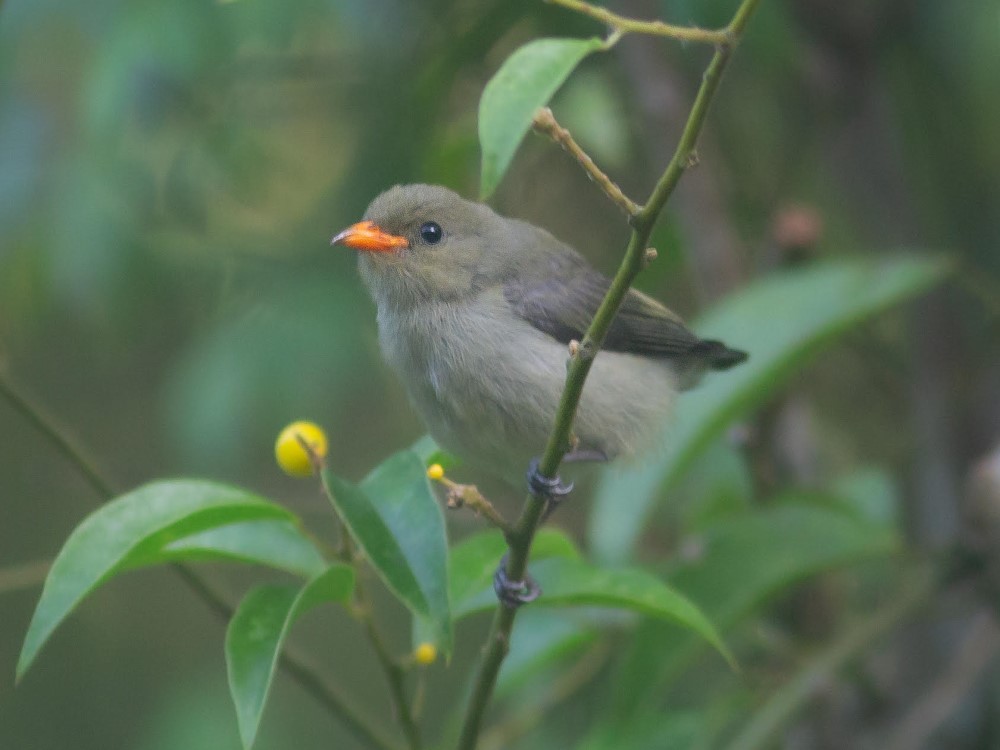Scarlet-backed Flowerpecker Dicaeum cruentatum 朱背啄花鳥
Category I. Locally common breeding resident with some dispersal in winter.
IDENTIFICATION

Oct. 2021, Chun Fai LO. Adult male.
7-9 cm. Tiny and highly active. The adult male is very distinctive and has a broad red band running from the crown to the rump, which contrasts with the blackish face and sides to the neck and flanks, and the blue-tinged wings. From below the white throat is highlighted by the black sides to the face, while the rest of the upperparts are whitish, greyer along the flanks.

Nov. 2019, Stephen Matthews. Female.
The female is olive-brown above, pale below and has scarlet upper tail coverts that contrast with the blackish upper tail. Compared to Fire-breasted it is browner above, less buff below and has scarlet uppertail coverts.

May 2021, Morten Lisse. Juvenile.
Juveniles are similar to females but have duller upperparts and a pale orange bill, which gradually gets darker with age.
VOCALISATIONS
Utters five main types of vocalisation (c.f. Fire-breasted Flowerpecker). Variants of all these may occasionally be heard that seem to be related to age or excitement level, and it may be necessary to listen for some time before it is clear whether it is this species or Fire-breasted Flowerpecker that is vocalising.
The seesaw song is given from at least March to July. On average it differs from the seesaw song of Fire-breasted Flowerpecker in being of slightly longer duration, slightly lower in pitch, slower in pace, and in containing fewer elements; it often trails off somewhat terminally. In general, it sounds less forceful.
The ‘rising twitter’ is often uttered following a series of ‘chik’ calls (see below), but generally it differs from the equivalent vocalisation of Fire-breasted in being much less forceful and assured, and in containing fewer elements and shorter, more hesitant phrases.
The ‘chik’ call is the usual call in flight but is also uttered when perched. As a simple, extremely short broadband sound, it is extremely similar to the equivalent call of Fire-breasted Flowerpecker, though it may sound slightly lower-pitched.
The ‘tseet’ call appears to be very similar to that of Fire-breasted Flowerpecker, though more frequently uttered.
The only vocalisation that stands apart from those of Fire-breasted Flowerpecker and is thus diagnostic in a HK context is a rising ‘tseet’. Usually this is a pure sound, but it may have a buzzing quality. There are three types. The first is a simple monosyllabic note that rises throughout.
The second is reminiscent of the typical call of Yellow-browed Warbler, though thinner and higher in pitch. It thus appears as a V-shape on a sonogram, either with or without an initial rise, though is more of a diphthong than disyllabic. A variant of this is uttered at such a fast pace that it sounds similar to the first type.
In the third type the rising and falling elements are spaced such that the call sounds disyllabic.
DISTRIBUTION & HABITAT PREFERENCE
Scarlet-backed Flowerpecker is restricted to areas with large trees and is relatively scarce in the younger areas of broadleaf forest; instead, it is most frequent in fung shui woods and other patches of large trees near villages in the lowlands of the central and eastern New Territories. It is rather scarce on HK and Lantau Islands (and appears to be largely a passage migrant and winter visitor) and absent or rare on the other islands and in urban Kowloon, where again it largely occurs on passage).
This rather unusual distribution and habitat preference reflects its close association with parasitic plants, especially Oriental Mistletoe Viscum ovalifolium, which are most frequently found on older trees planted around villages.
OCCURRENCE
The first observation of a Scarlet-backed Flowerpecker in HK was of a bird at Shing Mun on 11 January 1933 (Herklots and Taylor 1933). This date is probably a reflection of earlier observers’ concentration on the birds of HK Island and, given the species' habits and habitat preferences, is unlikely to have represented a recent colonisation. Subsequently, it was considered to occur regularly in such localities as Kam Tin and Lam Tsuen (Herklots 1967) and these areas remain favoured sites for this species.
Herklots (1953) knew of only one record from HK Island, a party in the Pok Fu Lam area during the winter of 1949-50. From 1958 to 1983 small numbers were recorded on the Island during most winters, with favoured areas being HK University, Mid-Levels and the area around the former Government House in Central. It is notable that these are all areas with large mature trees.
Changes in the range of this species in HK are somewhat opaque. Carey et al. (2001) stated that the non-breeding range was less extensive than that described by Chalmers (1986), who considered it regular in winter in Kowloon and on HK Island, noting that the increase in records from these areas documented by the latter had not been sustained. Similarly, the breeding season distribution may have declined in the period between the two breeding bird surveys of 1993-96 and 2016-19, as the percentage of 1 km squares occupied fell from 9.4% to 8.8%; however, the mapped distributions actually suggested that there might have been a slight expansion in range between the two periods, with records from five squares on HK Island and three squares on Lantau Island in the second survey period, compared to records from one and no squares, respectively, in the first period, despite there being no limitation on survey duration in the earlier survey.
The atlas survey findings suggest that the decline has continued this century, with the percentage of occupied 1 km squares falling from 13.7% to 13.1% between the winter atlas surveys of 2001-05 and 2016-19 (unlike the first breeding survey, both these surveys followed the same protocol with the survey duration restricted). However, eBird records, the majority of which postdate the second survey periods, paint a somewhat different picture, suggesting a much wider distribution on both HK and Lantau Islands, in particular, and also include records from migration hot spots in Kowloon outside the breeding season (eBird 2024).
Clearly, however, on the other islands, Scarlet-backed Flowerpecker remains scarce to rare. There was a single record on Lamma Island during the 1993-96 breeding bird survey, but the only other record is of one in the south of the island in September 2013. On Cheung Chau, which has received year-round coverage since the late 1980s, it is rare. A female during 27-28 December 2019 appears to be the first observation from there, and subsequently there have been only a handful of records of up to two birds, all in winter. One was also recorded on the rarely-visited Sunshine Island on 29 November 2018, whilst on well-watched Po Toi Island it was observed in seven years between 2011 and 2024 in April and between August and December, with a clear peak in November (suggesting movement of some sort); all observations there were of one or two birds except for a count of three on 11 October 2024.
BREEDING
There are remarkably few observations of breeding activity in HK; indeed, as noted above, it is not even clear as to whether there is a regular, established, breeding population on HK and Lantau Islands. Copulation was observed in Central on the rather unusual date of 27 December 1978, while collection of nest material has been noted on 16 June and 28 October (in an acacia tree). Dependent juveniles have been noted from 14 May to 6 October. These dates indicate that Scarlet-backed Flowerpecker is double or even triple-brooded in HK. Despite this, there are relatively few reports of breeding behaviour .
BEHAVIOUR, FORAGING & DIET
The relationship with parasitic plants is mutualistic, with the flowerpecker spreading the sticky seeds, but the bird is not wholly dependent upon this type of plant, and it also feeds on other fruit, notably Chinese Hackberry Celtis sinensis.
RANGE & SYSTEMATICS
Occurs from the eastern Himalayas east through south China to the east coast and south through mainland southeast Asia to Sumatra and Borneo (Cheke and Mann 2020). In China, resident in southern coastal provinces, Hainan and Yunnan (Liu and Chen 2021). There are six races; the nominate race is found throughout the entire mainland range, the other races are restricted to islands in the Indonesian Archipelago.
CONSERVATION STATUS
IUCN: Least Concern. Population trend decreasing.
Carey, G. J., M. L. Chalmers, D. A. Diskin, P. R. Kennerley, P. J. Leader, M. R. Leven, R. W. Lewthwaite, D. S. Melville, M. Turnbull and L. Young (2001). The Avifauna of Hong Kong. Hong Kong Bird Watching Society, Hong Kong.
Chalmers, M. L. (1986). Annotated Checklist of the Birds of Hong Kong. Hong Kong Bird Watching Society, Hong Kong.
Cheke, R. and C. Mann (2020). Scarlet-backed Flowerpecker (Dicaeum cruentatum), version 1.0. In Birds of the World (J. del Hoyo, A. Elliott, J. Sargatal, D. A. Christie, and E. de Juana, Editors). Cornell Lab of Ornithology, Ithaca, NY, USA. https://doi.org/10.2173/bow.scbflo1.01
eBird. 2024. eBird: An online database of bird distribution and abundance [web application]. eBird, Cornell Lab of Ornithology, Ithaca, New York. Available: http://www.ebird.org. (Accessed: 24 November 2024).
Herklots, G. A. C. (1953). Hong Kong Birds. South China Morning Post, Hong Kong.
Herklots, G. A. C. and M. Taylor (1933). Notes and Comments. Ornithology. Hong Kong Naturalist 4: 71-75.
Liu, Y. and S. H. Chen (eds) (2021). The CNG Field Guide to the Birds of China (in Chinese). Hunan Science and Technology Publication House, Changsha.

